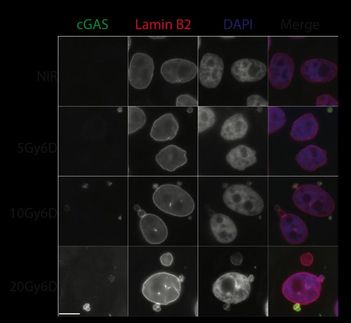ICAT Proteomics Technology Reveals Connection Between Two Cellular Structures
Both Structures Defective in Human Cancers
Advertisement
A combination of novel techniques for identifying key proteins and imaging their localization in cells is proving to be powerful method for unraveling possible mechanisms underlying cancerous growth. In the November issue of Molecular Cell, researchers at the Institute for systems biology (ISB) report that technology developed at the ISB and applied in a new way to fission yeast, a model organism sharing striking similarity with growth mechanisms in humans, has led to an important new insight that could lead to a better understanding of how cellular growth becomes unregulated during carcinogenesis.
Recent research has shown that protein structures, known as centrosomes (literally central bodies), accumulate abnormally in cancer cells and patient tumors. A central question has revolved around the connection between these structures and defects in cell division during cancer. Research at the ISB, led by scientist Dr. Mark Flory in Dr. Ruedi Aebersold's laboratory, has used the Isotope Coded Affinity Tag (ICAT) method and quantitative mass spectrometry to find proteins associated with these accumulated centrosomes.
"In this case, proteomic analysis was extremely effective in identifying proteins mediating an interaction between the centrosome, a molecular structure facilitating proper cell division, and telomere sequences at chromosome ends," stated Dr. Flory. "Both centrosomes and telomeres are strikingly abnormal in many types of human cancers, and our data suggest that an inappropriate centrosome-telomere interaction may be fundamental to initiation and progression of carcinogenesis."
Flory and his colleagues have now devised directed strategies to identify related proteins in human cancer cell lines, and these human proteins could potentially serve as future diagnostic biomarkers and targets for clinical therapeutics.
IFlory collaborated with Dr. Eric Muller at the Yeast Resource Consortium at the University of Washington and used high-resolution fluorescence microscopy to examine where these newly identified proteins are located in cells. One particularly intriguing protein was found to normally guard the ends of DNA chromosomes, or telomeres, from premature shortening. Flory and co-workers showed that the recruitment of this protein away from telomeres leaves chromosome ends exposed, resulting in DNA damage and growth defects highly reminiscent to those seen in human cancer cells and tumors.
Model organisms such as fission yeast provide relatively simple systems in which to study central biological questions and the insights can then be applied to humans. Although simple, these model systems provide advantageous platforms for technology development, integrative computational research, and biological discovery.
Based on the connection found in fission yeast, Flory suggests that accumulated centrosomes may disrupt normal cell growth by recruiting and inhibiting proteins that normally function to protect DNA. This could serve as a critical mechanism driving cancerous growth.



























































